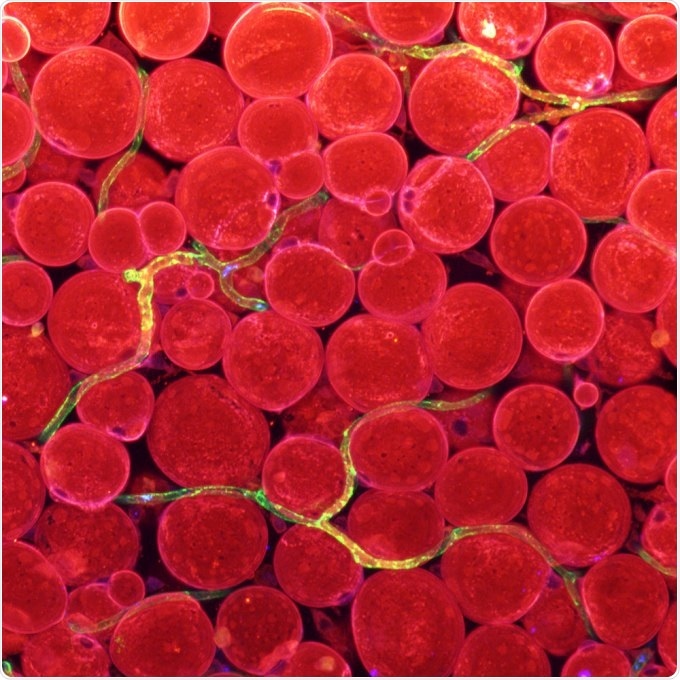Obesity is a highly debatable topic, especially when it comes to defining health. Despite this fact, obesity is usually categorized into metabolically healthy obesity (MHO) and also into an unhealthy version of obesity.

Fatty acid transporters (CD36; blue) in blood vessels (green), whose overlapping shown in yellow-green, transverse around fat cells (red) under the skin. Image Credit: Institute for Basic Science.
As people grow older, they tend to put on excess amounts of fat, particularly around the waist than the legs and hips—that is, they become more “apple-shaped” than “pear-shaped” and also face an increased risk of metabolic syndrome.
When fat builds up around an individual’s abdominal organs, rather than under the skin where a majority of the human body fat is often present, this visceral fat discharges inflammatory substances and fatty acids directly into the liver, inducing insulin resistance and toxicity.
Meanwhile, people suffering from MHO are defined by favorable health parameters, such as less inflammation, absence of hypertension, high insulin sensitivity, and a healthier immune system.
It is indisputable that the location of the body fat is crucial for health, but not much is known about the mechanism that determines whether a person has the apple shape or the pear shape
Headed by Dr. KOH Gou Young from the Center for Vascular Research, within the Institute for Basic Science (IBS), South Korea, researchers have reported a hormone called Angiopoietin-2 (Angpt2) that is secreted from fat tissues. It is a key driver that prevents the accumulation of potbellies by allowing the proper transport of fatty acid into general circulation in blood vessels, therefore preventing insulin resistance.
This hormone was earlier called a protein-coding peptide that plays a role in embryonic vascular development.
The researchers’ outcomes were published online in the Nature Communications journal on June 12th, 2020.
Previous approaches blocked the expression of Angpt2 in the whole circulatory system with pharmacological interventions to inhibit displaced fat accumulation that leads to metabolic disorders. Though the vascular endothelial cell is the anatomic and metabolic gatekeeper of fat shuttling into tissues, it has still remained uncertain whether the displaced accumulation of excess fat in fat tissues is a cause or an indicator of metabolic syndrome.”
Bae Hosung, Study First Author, Institute for Basic Science
Hosung continued, “We specifically focused on the fatty acid shuttling in the specific fat tissues under the skin. Angpt2 is found to play a key role in packing on fat on proper locations where they should be to contain a wider waistline.”
The scientists noted that the blood vessels under the skin are home to specific fatty acid transport proteins, and subsequently compared samples from metabolically unhealthy obese and MHO persons. The Angpt2 hormone was identified to be the sole promising candidate for sustaining metabolic health through the regulation of body fat distribution.
By using numerous tissue-specific knockout mouse models and by performing mechanistic studies in primary cultured cells, the scientists demonstrated that the Angpt2 hormone produced by fat cells communicates with its receptor integrin α5β1 to ensure common distribution of circulating fat and drive fatty acid transporters.
Intriguingly, Angpt2–integrin α5β1 signaling took just few minutes. This near-instant processing makes sense since this biological mechanism should cope with the surge of fat levels in the blood after a meal.”
Bae Hosung, Study First Author, Institute for Basic Science
When this process was inhibited, it led to the accumulation of fat in abdominal organs and other fat depots, resulting in systemic glucose intolerance, reminiscent of the pattern seen in metabolically unhealthy obese individuals.
Researchers are yet to know if Angpt2 treatment can provide a therapeutic strategy to standardize the distribution of fat and treat metabolic disorders induced by obesity.
As demonstrated in earlier efforts, systemic modulation of the Angpt2 via pharmacological blockade is rather limited because Angpt2 is an individual hormone, and it relies on the heterogeneity of different fat depots.
On the other hand, a more feasible approach would be to activate fatty acid transporters or integrin receptors for its comparatively limited expression in fat cells present under the skin.
It requires further investigation to test these possibilities genetically or pharmaceutically to open new therapeutic paths for transformation of metabolically unhealthy obesity to healthy obesity.”
Bae Hosung, Study First Author, Institute for Basic Science
Source:
Journal reference:
Hosung, B., et al. (2020) Angiopoietin-2–integrin α5β1 signaling enhances vascular fatty acid transport and prevents ectopic lipid-induced insulin resistance. Nature Communications. doi.org/10.1038/s41467-020-16795-4.